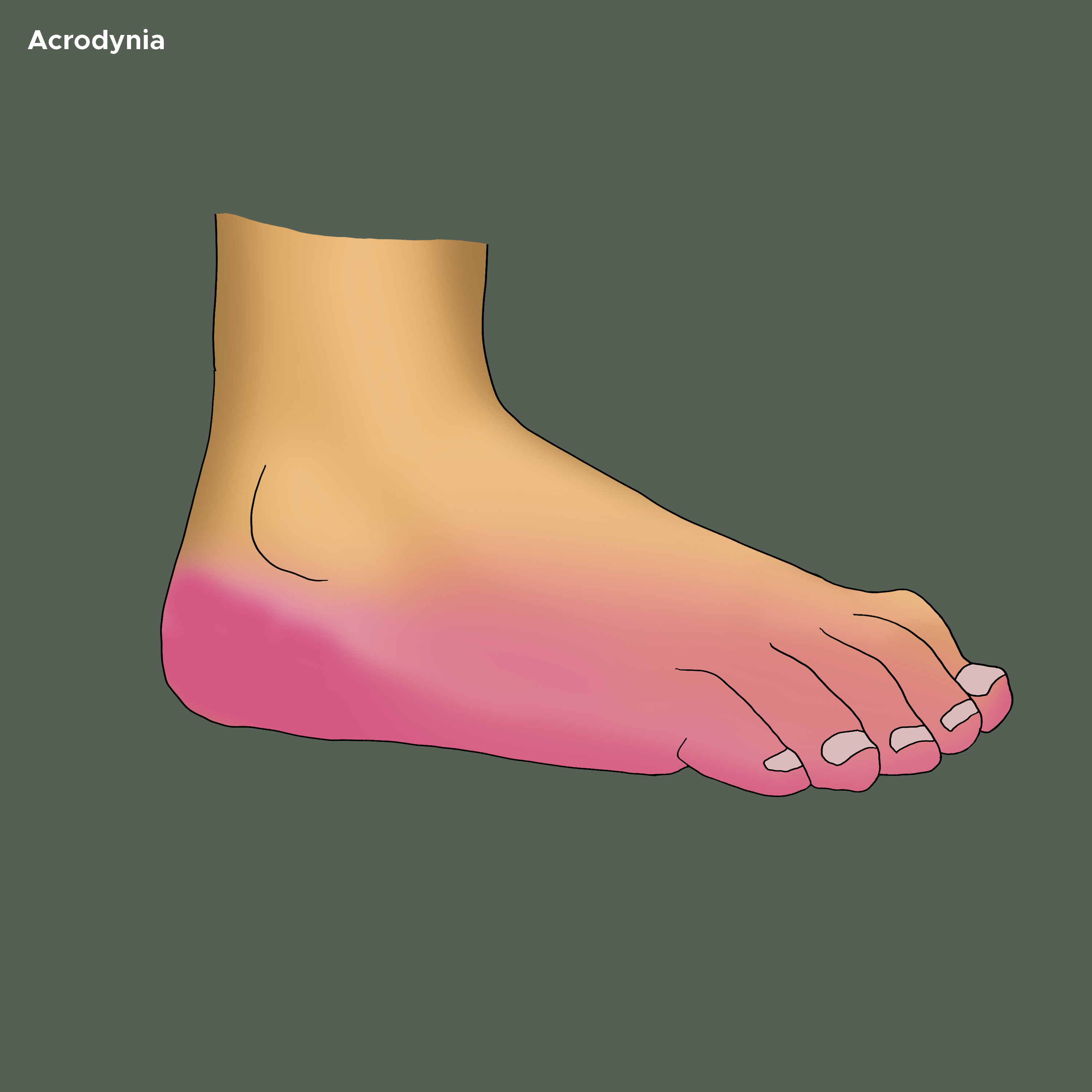[2]
Mercer JJ,Bercovitch L,Muglia JJ, Acrodynia and hypertension in a young girl secondary to elemental mercury toxicity acquired in the home. Pediatric dermatology. 2012 Mar-Apr;
[PubMed PMID: 22409470]
[3]
Michaeli-Yossef Y,Berkovitch M,Goldman M, Mercury intoxication in a 2-year-old girl: a diagnostic challenge for the physician. Pediatric nephrology (Berlin, Germany). 2007 Jun;
[PubMed PMID: 17310361]
[5]
Shandley K,Austin DW, Ancestry of pink disease (infantile acrodynia) identified as a risk factor for autism spectrum disorders. Journal of toxicology and environmental health. Part A. 2011;
[PubMed PMID: 21797771]
[7]
DATHAN JG,HARVEY CC, PINK DISEASE-TEN YEARS AFTER (THE EPILOGUE). British medical journal. 1965 May 1;
[PubMed PMID: 14273529]
[8]
Bose-O'Reilly S,McCarty KM,Steckling N,Lettmeier B, Mercury exposure and children's health. Current problems in pediatric and adolescent health care. 2010 Sep;
[PubMed PMID: 20816346]
[9]
Weinstein M,Bernstein S, Pink ladies: mercury poisoning in twin girls. CMAJ : Canadian Medical Association journal = journal de l'Association medicale canadienne. 2003 Jan 21;
[PubMed PMID: 12538551]
[10]
Austin DW,Spolding B,Gondalia S,Shandley K,Palombo EA,Knowles S,Walder K, Genetic variation associated with hypersensitivity to mercury. Toxicology international. 2014 Sep-Dec;
[PubMed PMID: 25948960]
[11]
Houston MC, Role of mercury toxicity in hypertension, cardiovascular disease, and stroke. Journal of clinical hypertension (Greenwich, Conn.). 2011 Aug;
[PubMed PMID: 21806773]
[12]
Ding Y,Song R,Li CJ, [The neurological manifestations of chronic mercury poisoning]. Zhonghua nei ke za zhi. 2011 Nov;
[PubMed PMID: 22333129]
[13]
Schwartz JG,Snider TE,Montiel MM, Toxicity of a family from vacuumed mercury. The American journal of emergency medicine. 1992 May;
[PubMed PMID: 1316757]
[14]
Park JD,Zheng W, Human exposure and health effects of inorganic and elemental mercury. Journal of preventive medicine and public health = Yebang Uihakhoe chi. 2012 Nov;
[PubMed PMID: 23230464]
[16]
Hong YS,Kim YM,Lee KE, Methylmercury exposure and health effects. Journal of preventive medicine and public health = Yebang Uihakhoe chi. 2012 Nov;
[PubMed PMID: 23230465]
[17]
Ekinci M,Ceylan E,Keleş S,Cağatay HH,Apil A,Tanyıldız B,Uludag G, Toxic effects of chronic mercury exposure on the retinal nerve fiber layer and macular and choroidal thickness in industrial mercury battery workers. Medical science monitor : international medical journal of experimental and clinical research. 2014 Jul 24;
[PubMed PMID: 25056093]
[18]
Lai O,Parsi KK,Wu D,Konia TH,Younts A,Sinha N,McNelis A,Sharon VR, Mercury toxicity presenting as acrodynia and a papulovesicular eruption in a 5-year-old girl. Dermatology online journal. 2016 Mar 16;
[PubMed PMID: 27136627]
[19]
Boyd AS,Seger D,Vannucci S,Langley M,Abraham JL,King LE Jr, Mercury exposure and cutaneous disease. Journal of the American Academy of Dermatology. 2000 Jul;
[PubMed PMID: 10863229]
[20]
Wyllie WG,Stern RO, Pink Disease: its Morbid Anatomy, with a Note on Treatment. Archives of disease in childhood. 1931 Jun;
[PubMed PMID: 21031845]
[21]
Javett SN,Kaplan B, Acrodynia treated with D-penicillamine. American journal of diseases of children (1960). 1968 Jan;
[PubMed PMID: 5635062]
[23]
Nayfeh A,Kassim T,Addasi N,Alghoula F,Holewinski C,Depew Z, A Challenging Case of Acute Mercury Toxicity. Case reports in medicine. 2018;
[PubMed PMID: 29559996]
Level 3 (low-level) evidence
[24]
Carter M,Abdi A,Naz F,Thabet F,Vyas A, A Mercury Toxicity Case Complicated by Hyponatremia and Abnormal Endocrinological Test Results. Pediatrics. 2017 Aug;
[PubMed PMID: 28701428]
Level 3 (low-level) evidence
[25]
Kazantzis G, Mercury exposure and early effects: an overview. La Medicina del lavoro. 2002 May-Jun;
[PubMed PMID: 12197264]
Level 3 (low-level) evidence
[26]
Nuttall KL, Interpreting hair mercury levels in individual patients. Annals of clinical and laboratory science. 2006 Summer;
[PubMed PMID: 16951265]
[27]
Ţincu RC,Cobilinschi C,Ghiorghiu Z,Macovei RA, Acute mercury poisoning from occult ritual use. Romanian journal of anaesthesia and intensive care. 2016 Apr;
[PubMed PMID: 28913479]
[28]
Forman J,Moline J,Cernichiari E,Sayegh S,Torres JC,Landrigan MM,Hudson J,Adel HN,Landrigan PJ, A cluster of pediatric metallic mercury exposure cases treated with meso-2,3-dimercaptosuccinic acid (DMSA) Environmental health perspectives. 2000 Jun;
[PubMed PMID: 10856034]
Level 3 (low-level) evidence
[29]
Rafati-Rahimzadeh M,Rafati-Rahimzadeh M,Kazemi S,Moghadamnia AA, Current approaches of the management of mercury poisoning: need of the hour. Daru : journal of Faculty of Pharmacy, Tehran University of Medical Sciences. 2014 Jun 2;
[PubMed PMID: 24888360]
[30]
Güngör O,Özkaya AK,Kirik S,Dalkiran T,Güngör G,Işikay S,Davutoğlu M,Dilber C, Acute Mercury Poisoning in a Group of School Children. Pediatric emergency care. 2019 Oct;
[PubMed PMID: 27977534]
[31]
Yoshida M, Satoh H, Igarashi M, Akashi K, Yamamura Y, Yoshida K. Acute mercury poisoning by intentional ingestion of mercuric chloride. The Tohoku journal of experimental medicine. 1997 Aug:182(4):347-52
[PubMed PMID: 9352627]
[33]
Brannan EH,Su S,Alverson BK, Elemental mercury poisoning presenting as hypertension in a young child. Pediatric emergency care. 2012 Aug;
[PubMed PMID: 22863825]
[34]
Khodashenas E,Aelami M,Balali-Mood M, Mercury poisoning in two 13-year-old twin sisters. Journal of research in medical sciences : the official journal of Isfahan University of Medical Sciences. 2015 Mar;
[PubMed PMID: 26109979]
[35]
Yeter D,Portman MA,Aschner M,Farina M,Chan WC,Hsieh KS,Kuo HC, Ethnic Kawasaki Disease Risk Associated with Blood Mercury and Cadmium in U.S. Children. International journal of environmental research and public health. 2016 Jan 5;
[PubMed PMID: 26742052]
[36]
Yeter D,Deth R,Kuo HC, Mercury promotes catecholamines which potentiate mercurial autoimmunity and vasodilation: implications for inositol 1,4,5-triphosphate 3-kinase C susceptibility in kawasaki syndrome. Korean circulation journal. 2013 Sep;
[PubMed PMID: 24174958]
[37]
Sasan MS,Hadavi N,Afshari R,Mousavi SR,Alizadeh A,Balali-Mood M, Metal mercury poisoning in two boys initially treated for brucellosis in Mashhad, Iran. Human
[PubMed PMID: 21803782]
[38]
Dally A, The rise and fall of pink disease. Social history of medicine : the journal of the Society for the Social History of Medicine. 1997 Aug;
[PubMed PMID: 11619497]

